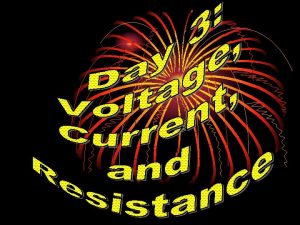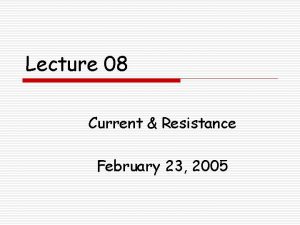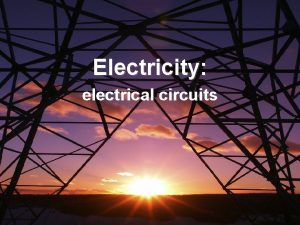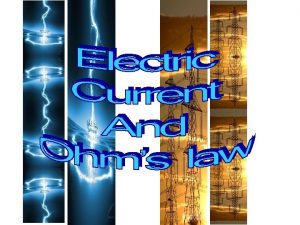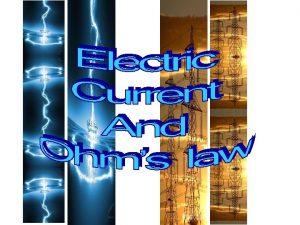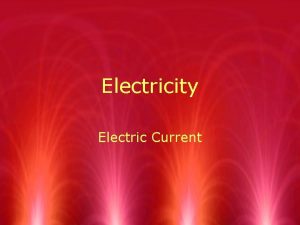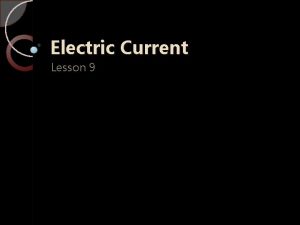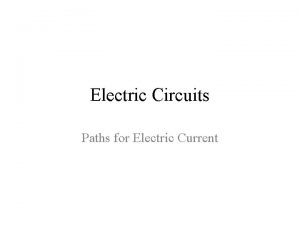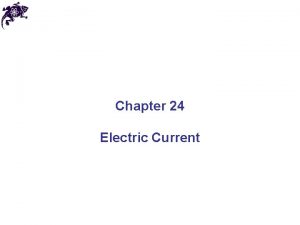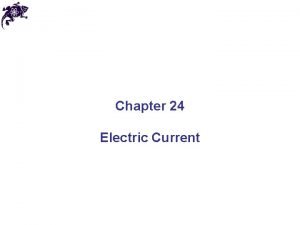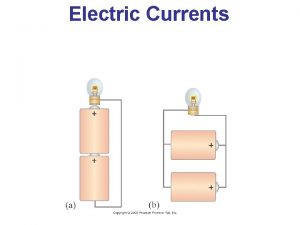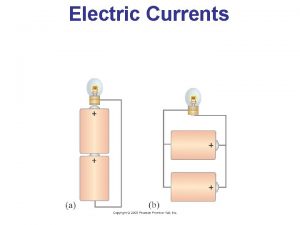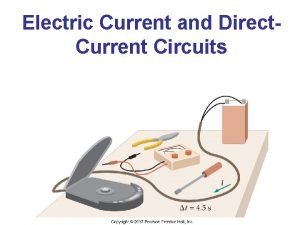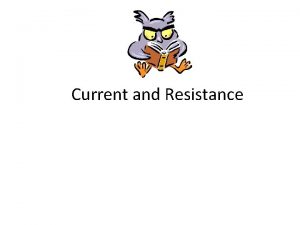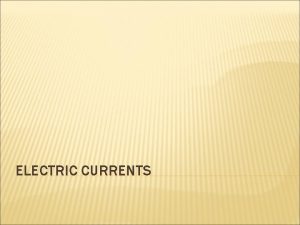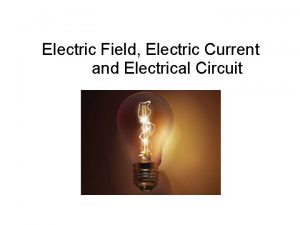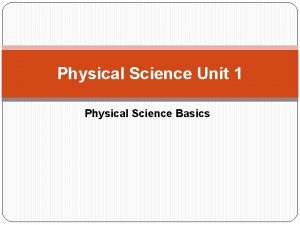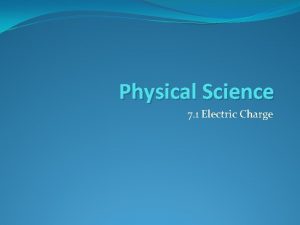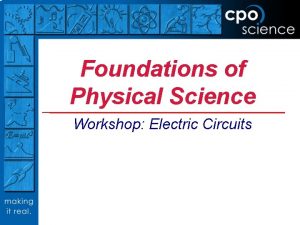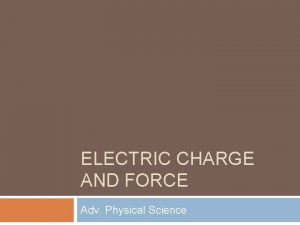PHYSICAL SCIENCE 7 2 Electric Current Electric Current





















- Slides: 21

PHYSICAL SCIENCE 7. 2 Electric Current

Electric Current 7. 2 Current and Voltage Difference • When an electric current flows in the wire, electrons continue their random movement, but they also drift in the direction that the current flows. • Electric current is measured in amperes.

Electric Current 7. 2 Voltage Difference • In some ways, the electric force that causes charges to flow is similar to the force acting on the water in a pipe. • Water flows from higher pressure to lower pressure.

Electric Current 7. 2 Voltage Difference • In a similar way, electric charge flows from higher voltage to lower voltage. • A voltage difference is related to the force that causes electric charges to flow. Voltage difference is measured in volts.

Electric Current 7. 2 Electric Circuits • This figure shows an electric current doing work by lighting a lightbulb. • A closed path that electric current follows is a circuit. • If the circuit is broken by removing the battery, or the lightbulb, or one of the wires, current will not flow.

Electric Current 7. 2 Batteries • To keep an electric current continually flowing in the electric circuit a voltage difference needs to be maintained in the circuit. • A battery can provide the voltage difference that is needed to keep current flowing in a circuit. • Current flows as long as there is a closed path that connects one battery terminal to the other battery terminal.

Electric Current 7. 2 Dry-Cell Batteries • A cell consists of two electrodes surrounded by a material called an electrolyte. • The electrolyte enables charges to move from one electrode to the other.

Electric Current 7. 2 Dry-Cell Batteries • One electrode is the carbon rod, and the other is the zinc container. • The electrolyte is a moist paste containing several chemicals. • The cell is called a dry cell because the electrolyte is a moist paste, and not a liquid solution.

Electric Current 7. 2 Wet-Cell Batteries • A wet cell contains two connected plates made of different metals or metallic compounds in a conducting solution. • A wet-cell battery contains several wet cells connected together.

Electric Current 7. 2 Resistance • As the electrons flow through the filament in a lightbulb, they bump into the metal atoms that make up the filament. • In these collisions, some of the electrical energy of the electrons is converted into thermal energy.

Electric Current 7. 2 Resistance • Eventually, the metal filament becomes hot enough to glow, producing radiant energy that can light up a dark room.

Electric Current 7. 2 Resisting the Flow of Current • Resistance is the tendency for a material to oppose the flow of electrons, changing electrical energy into thermal energy and light. • With the exception of some substances that become superconductors at low temperatures, all materials have some electrical resistance. • Resistance is measured in ohms ( ).

Electric Current 7. 2 Temperature, Length, and Thickness • The electric resistance of most materials usually increases as the temperature of the material increases. • The resistance of an object such as a wire also depends on the length and diameter of the wire.

Electric Current 7. 2 Temperature, Length, and Thickness • The resistance of a wire, or any conductor, increases as the wire becomes longer. • The resistance also increases as the wire becomes thinner.

Electric Current 7. 2 The Current in a Simple Circuit • A simple electric circuit contains a source of voltage difference, such as a battery, a device, such as a lightbulb, that has resistance, and conductors that connect the device to the battery terminals. • When the wires are connected to the battery terminals, current flows in the closed path.

Electric Current 7. 2 The Current in a Simple Circuit • The voltage difference, current, and resistance in a circuit are related.

Electric Current 7. 2 Ohm's Law • According to Ohm's law, the current in a circuit equals the voltage difference divided by the resistance. • If I stands for the electric current, Ohm's law can be written as the following equation.

Section Check 7. 2 Question 1 _____ is the net movement of electric charges in a single direction. A. An open circuit B. Electric current C. Proton flow D. Voltage

Section Check 7. 2 Answer The answer is B. Electric forces in a material cause electric current to flow.

Section Check 7. 2 Question 2 What is a volt? Answer A volt is the unit of measurement for voltage difference, which is related to the force that causes electric charges to flow.

Section Check 7. 2 Question 3 What is the tendency for a material to oppose the flow of electrons called? Answer The tendency for a material to oppose the flow of electrons is called resistance, and is measured in ohms.
 Branches of natural science
Branches of natural science Natural science vs physical science
Natural science vs physical science What is your favorite lesson
What is your favorite lesson Line current and phase current
Line current and phase current Line current and phase current
Line current and phase current Drift current and diffusion current
Drift current and diffusion current Ac theory 3 lesson 4
Ac theory 3 lesson 4 Drift current density unit
Drift current density unit Drift current and diffusion current
Drift current and diffusion current The value of vgs that makes id approximately zero is the
The value of vgs that makes id approximately zero is the In a ∆-connected source feeding a y-connected load
In a ∆-connected source feeding a y-connected load Infineon
Infineon Drift current density unit
Drift current density unit Chapter 3 shielded metal arc welding
Chapter 3 shielded metal arc welding Touch current vs leakage current
Touch current vs leakage current Kcl mesh analysis
Kcl mesh analysis Voltage drop def
Voltage drop def Resistance is the opposition to
Resistance is the opposition to What is the nature of electricity
What is the nature of electricity Chapter 23 electric current circuit happenings
Chapter 23 electric current circuit happenings What is displacement current
What is displacement current Parallel circuit
Parallel circuit
















